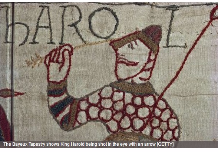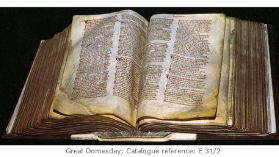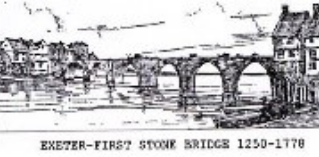
INVASION, TWO SIEGES AND A CIVIL WAR
13 October 2016
Exactly 950 years and 4 days after the Battle of Hastings in 1066, Malcolm Foster gave us a talk about the circumstances of that battle and how it and the Norman invasion affected Exeter.
Vikings had once been the kings in England but by 1066 the Saxons were back in charge. However, when the Saxon king died with no heir the English throne was “up for grabs”. Harold, Earl of Wessex and brother-in-law to the king, marched to Winchester and claimed the crown. But Harrald Hardrada, a Viking in Norway, also felt he had a claim as he was a direct descendant of King Knut, so he sailed to the north of England to claim the throne. Harold of Wessex had no choice but to walk to Yorkshire - which he and his army managed in only four days ! They defeated Harrald but in the meantime William of Normandy was claiming to have been promised the throne by the English king.
William was forced to wait for a favourable wind to cross the Channel. But he eventually succeeded in crossing using 53 ships to carry his army and all its weapons, including siege engines. We know that William also brought a complete wooden castle, in sections, with him (only 9 ships were needed for the return to France!!).
Why did William choose the area of Hastings for his landing? The village lay between two high cliffs giving great defence ability and there was only one easily defended road leading to it from the land. Also, there was an old Roman Fort nearby, which was used for an initial, easily defended,camp.
Now poor Harold and his army had to leave Yorkshire and walk the length of England to do battle with William on the south coast. Exhausted after their round trip to Yorkshire and back plus their victorious battle against the Vikings, they neverless attempted to take on the Normans.. Anglo Saxon tactics were to fight with large axes held in the left hand thus effectively combatting an enemy’s right-handed sword and shield. This time, however, this was not enough and, as we all know, they lost the battle.
From there, as the Normans moved inland, they wrecked or destroyed everything in their path. Wherever they set up camp they were as noisy as possible to announce their arrival and frighten the population.
William was crowned King on Christmas Day 1066. “What sort of king was he?”. The famous Anglo-Saxon Chronicle (actually five volumes combined), suggests that William was a devout Christian who was said to be stern with enemies though kind to those who loved God. However, he demanded that everyone must submit themselves totally to him! When William caused castles to be built, the cost was charged to locals and the labourers were pressed hard and badly paid. Laws were strict and harshly enforced. Anyone caught killing a “hart or hind” ie a deer, would be blinded.
The King “owned” everything in the country and rented out to his Norman barons those pieces of land that were of lesser interest to him. In return they had to supply soldiers whenever the King requested them. They built castles to protect themselves and rented out parts of their lands to their knights. Down at the bottom of the pecking order were the serfs who tilled the land, paid rents and were also expected to fight whenever needed. The old Saxon system of owning slaves was discontinued by the Normans.
William levied heavy taxes on his subjects and to enable him to know exactly where to levy them the Doomsday Book was produced. It is especially detailed about Devon, showing numbers of animals (pigs, sheep, horses etc.) in every settlement. The King is shown to own 300 houses in Exeter, providing rents to him, and 60 houses having been destroyed since he came to England. Exeter is listed as the third most important city in the country.
So Exeter was wealthy. William levied his tax on the city, but the obstinate Ango Saxons in Exeter refused to pay up! In due course, William brought an army to Exeter to enforce payment and besieged the city. In those days surrounding a city and therefore starving out the inhabitants was a usually successful policy. But Exeter planned well and was well stocked with food and water and was able to hold out against William. As a warning to all the citizens, he then captured a Saxon leader and, to make an example of him, “put out his eyes” in full view of the city’s inhabitants. They held out for 18 days, shut inside their walled city, but finally gave in. They feared that they too would be punished. Fortunately William realised he would lose financially if they were all killed so he let them off in return for payment of taxes.
Exeter prospered under the Normans who changed the course of the river, providing a new bridge with numerous arches over the River Exe, and repaired and rebuilt the city walls. The main castle, originally built by the Romans, was reconstructed. The castle was situated on top of a hill known, in French, as rouge mont (because of its red rock) so inevitably the castle became known as Rougemont Castle.
Examination of the castle walls (right) shows the original Roman construction at the base, the Anglo Saxon improvements above, and the Norman development above that..
William’s son, Henry I, had no living male descendant. He had his barons swear that his daughter Matilda should be queen on his death. However, her cousin, Stephen (a grandson of William through his mother) claimed the throne so there was war again in England.
Sir Baldwin de Redvers, feudal baron of Plympton,was one of the first to rebel against Stephen, and was the only first-rank baron never to accept the new king. He seized Exeter, capturing the castle in the name of Matilda – also confusingly known as Empress Maud. The castle was besieged by Stephen and held out until the water supply dried up. Then Baldwin sent his wife out to see the king and she successfully negotiated a surrender. He then went to the Isle of Wight and attacked the king’s shipping there but when driven out of England joined the Empress Matilda in Anjou. She made him Earl of Devon, probably in 1141.
Although it is not common knowledge, Stephen is accredited with starting the construction of another castle while he was besieging Exeter.
Behind Exeter prison can still be seen a doughnut-shaped mound which was the base ffor the new wooden castle. The project was abandoned, unfinished, once Baldwin surrendered.
Exeter’s strong walls and castle ensured that the city was never invaded again - unless you count the aerial bombardment in 1942!




